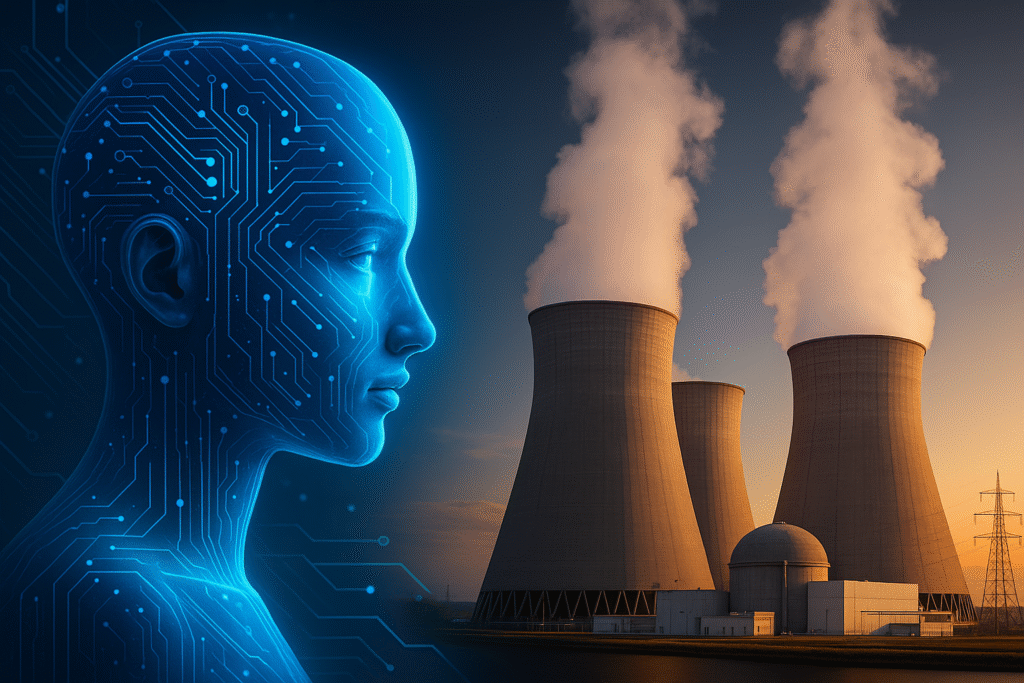In the ever evolving technological landscape, Artificial Intelligence and nuclear energy have emerged as an unlikely yet critical partnership shaping the future of global industries. As the demand for AI capabilities skyrockets, so does the insatiable need for reliable, large scale energy sources. Big Tech companies are now turning to nuclear energy producers to fuel their AI ambitions marking a transformative moment for both sectors.
The Energy Conundrum Behind AI’s Rapid Growth
The last decade has seen minimal growth in overall U.S energy consumption, thanks to improved efficiency measures and renewable energy initiatives. However! this stability is on the verge of disruption. Over the next five years, electricity demand for powering data centers the lifeblood of AI development is expected to more than double.
Some forecasts suggest that by 2030, global data centers will consume as much electricity as the entire country of Japan does today. The sheer magnitude of this projection highlights a significant challenge how can we meet the exponential energy needs of AI without worsening climate change or overburdening aging power grids?
This is where the partnership between Artificial Intelligence and nuclear energy comes into sharp focus.
Big Tech’s Bet on Nuclear Energy
Major technology companies, including Microsoft, Google, and Amazon, have made bold commitments to carbon neutrality and sustainability. But building AI models, training algorithms, and maintaining vast server farms demand enormous energy resources far beyond what solar and wind alone can provide at scale and reliability.
Recognizing this gap, Big Tech is now investing heavily in nuclear energy, seeing it as a stable, carbon free solution to their energy dilemma. Nuclear power offers the reliability and massive output needed to sustain AI development while aligning with environmental commitments.
In recent years, Microsoft signed deals to purchase nuclear energy credits, while Google has explored direct investments in small modular reactors (SMRs) a next generation nuclear technology that promises safer, more scalable deployment. These moves signal a clear trend the future of Artificial Intelligence and nuclear energy is deeply intertwined.
Why Nuclear Energy Appeals to the AI Industry
The unique demands of AI development make nuclear energy an attractive option. Data centers require a constant, uninterrupted power supply, often referred to as “baseload power.” Unlike solar or wind, which depend on weather conditions, nuclear plants provide continuous electricity, making them ideal for meeting the 24/7 demands of AI operations.
Moreover! nuclear energy produces zero carbon emissions during operation, aligning with Big Tech’s climate goals. As AI continues to push boundaries in areas like machine learning, autonomous systems, and generative technologies, having a reliable, eco friendly power source becomes non negotiable.
The Bottlenecks Slowing the AI Nuclear Revolution
Despite the growing synergy between Artificial Intelligence and nuclear energy, significant hurdles remain. Building new nuclear power plants is a time consuming and politically sensitive process. Regulatory approvals, public opposition, and long construction timelines often stall projects for years, if not decades.
A senior advisor at the Wadhwani A.I center at the Center for Strategic and International Studies recently highlighted this dilemma: “Every investor is lining up to invest in the next AI breakthrough. But when it comes to energy, there is a challenge in terms of permitting, the reality of construction timelines for new power plants and new grid capabilities. All of this could slow down A.I just as the research and development is preparing for takeoff.”
The irony is clear just as AI research stands on the cusp of revolutionary breakthroughs the infrastructure to support its energy needs lags behind.
Small Modular Reactors: A Game Changer in the Making?
One potential solution to this bottleneck lies in small modular reactors (SMRs). Unlike traditional nuclear plants, SMRs are designed to be built in factories and assembled on site, reducing construction times and costs. Their smaller footprint and enhanced safety features also make them more politically palatable.
For the AI industry, SMRs offer a scalable, flexible energy source that could be deployed near data centers, reducing transmission losses and enhancing energy security.
Several startups and energy giants are racing to commercialize SMR technology. If successful, they could become the cornerstone of the partnership between Artificial Intelligence and nuclear energy, enabling Big Tech to meet its energy demands without compromising on environmental or logistical concerns.
The Broader Implications for Society and the Economy
The collaboration between Artificial Intelligence and nuclear energy extends far beyond the walls of data centers and corporate boardrooms. It represents a pivotal moment in how society balances technological advancement with environmental responsibility.
If AI continues its rapid evolution, powered by clean, reliable nuclear energy it could unlock unprecedented innovations in medicine, climate modeling, education, and beyond. But achieving this vision requires policymakers, industry leaders, and communities to work together streamlining regulatory processes and investing in next-generation energy infrastructure.
On the flip side, failure to address these energy challenges could stall AI progress widen the digital divide, and undermine global climate targets.
A Future Fueled by AI and Clean Energy
The convergence of Artificial Intelligence and nuclear energy underscores a profound truth about the 21st century: the future of technology is inseparable from the future of energy.
As AI reshapes industries, economies, and daily life, its hunger for power cannot be ignored. Nuclear energy with its unmatched reliability and zero carbon profile offers a viable path forward provided society can overcome regulatory hurdles and public skepticism.
For Big Tech! this partnership is not just a strategic move; it’s a necessity. For the world, it’s a chance to advance human potential while safeguarding the planet. In the years ahead, the success of AI may depend as much on kilowatts as on algorithms and nuclear energy could be the key to unlocking both.

